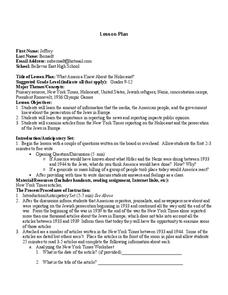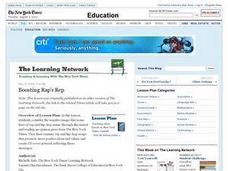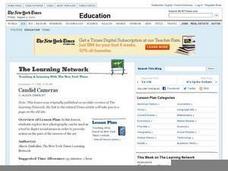Curated OER
Let the Games Begin
Pupils analyze how the New York Times uses small feature stories to cover aspects of a major international event, such as the Olympics, before it actually occurs. They brainstorm their own ideas for short feature stories on the Olympics
Curated OER
Mixing Metaphors with Politics
Young scholars discuss different literary devices and use them to write summaries of New York Times articles dealing with international news. They reflect on the effectiveness and appropriateness of sports metaphors in the political arena.
Curated OER
Poll Positions
Students analyze and graph the results of a nationwide New York Times poll about race in the United States. They poll people in their community regarding their views and experiences, and compare and contrast local and national poll data.
Curated OER
Hail to the Chief
Students explore how the New York Times has represented presidential victories on its front page throughout the 20th century.
Curated OER
The Truth Shall Set Them Free?
Pupils consider the notion and purpose of truth commissions, They work in groups to predict the commission's effectiveness in its efforts to promote peace and reconciliation among Liberians. Finally, students create found poems that...
Curated OER
Over the Borderline?
Students study President Bush's proposal for immigration policy in the US and examine various perspectives on immigration that are currently being debated. They read and discuss an online New York Times article.
Curated OER
What America Knew About the Holocaust?
Students examine American involvement in World War II. For this World War II lesson, students discuss the Holocaust and its implications. Students read New York Times articles regarding the treatment of Jews during the war. Students...
Curated OER
Boosting Rap's Rep
Students consider the negative image that some have of rap and hip-hop music through discussion and reading an opinion piece from The New York Times. They create CD cover artwork reflecting these messages.
Curated OER
Mixed Plate
Students locate a sample restaurant review in a newspaper or magazine. They examine the review to find the opinion of the reviewer and discuss reviews that convey mixed opinions. They compose an original review in a similar style to...
Curated OER
Separate Lives
Students read a New York Times article to explain apartheid and its legacies. They examine prejudice in their own lives by looking a the perception of discriminatory traits.
Curated OER
Coup-Operation in Pakistan
Young scholars, using a New York Times Article as a springboard for discussion, investigate the 1999 military coup in Pakistan. They generate further questions and research their answers.
Curated OER
Screening the Silver Screen
Students write New York Times Movie Guide Reviews using descriptive and persuasive language.
Curated OER
Spam University
Students read a New York Times article in order to consider the dissemination of information. They investigate the need for privacy as opposed to the need for information by looking at mass on-line and postal mail distributors.
Curated OER
Throwing It All Away?
Students read a New York Times article as part of their investigation as to what happens when an item is thrown away or recycled. They analyze the relationship between a product's ingredients and its effect on the Earth and healthful...
Curated OER
Candid Cameras
Learners read a New York Times article associated with the use of photography as a tool to depict social issues in order to provoke action. They create a Social Issues display.
Curated OER
Schools of Thought on Segregation
Students read a New York Times article in order to explain how American courts and communities are dealing with the unanimous Supreme Court decision to end "separate but equal" education. They analyze how this affects the nation's youth.
Curated OER
Where Math Meets Poetry
Students identify Fibonacci's sequence of numbers and use the pattern to write poetry with one syllable words. In this math and writing lesson, students identify Fibonacci's sequence of numbers and learn about this early mathematician....
Curated OER
An Incredible Journey: Exploring Brave New Worlds
Learners, after reading the novel, Brave New World, research in depth topics like the production and consumption of Henry Ford, Pavlov's and Skinner's behavioral science work, as well as the existence of Utopian and dystopian societies....
Curated OER
Time Zone Math
In this algebra worksheet, students calculate the different time of the day that different countries see the sun. They convert between different time zones. There are 3 questions with an answer key.
Curated OER
Determining the Time of an Earthquake
In this earthquake worksheet, learners will study a table showing the travel times of seismic waves from an earthquake. Students will use this information to determine when and where the earthquake occurred. This worksheet has 6 short...
Curated OER
Building New Landforms
In this landform activity, students read 6 paragraphs about the process the Dutch used to build new landforms and threats they face today. After reading the background information, students complete 3 short answer questions regarding...
Oklahoma State Department of Education
Narrative Prompt
Reading about history is nothing like experiencing it firsthand. Encourage your eighth graders to do the next best thing with a historical narrative prompt, in which they describe the experience of a first-time traveler on the...
Digital History
Representation: By State or by Population
Should representation in the new United States government be based on population? This worksheet illustrates the details of this important quandary through an adaptation of speeches on the topic given at the Constitutional Convention....
Curated OER
My Antonia: Bloom’s Taxonomy Questions
How well do your pupils know My Antonia by Willa Cather? Take some time to create questions about the text. After examining a teacher model, individuals write questions that match each level of Bloom's Taxonomy and draft answers to these...























